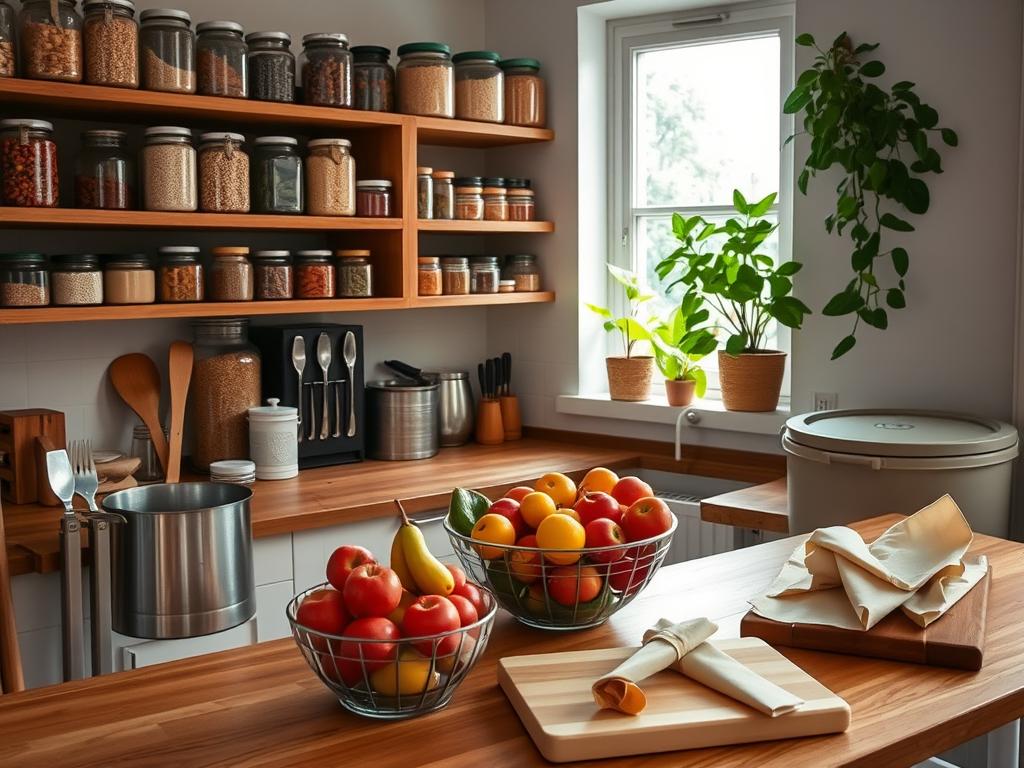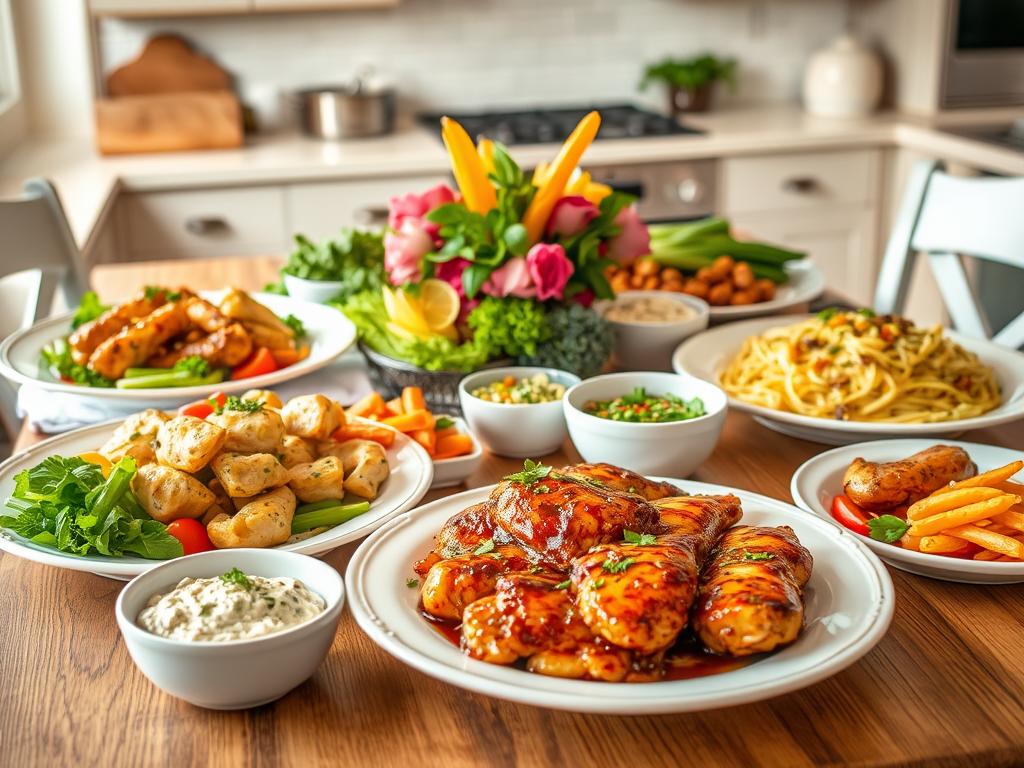Imagine sipping your morning tea, enjoying the smell and warmth. But did you know you might be drinking tiny plastic pieces? A study found that one plastic teabag can release billions of microplastics into your tea. This shows how plastics quietly take over our kitchens and lives.
Starting a zero waste kitchen means being aware. We’ll explore how to cook and store food in eco-friendly ways. We’ll see how plastic kitchen items, like sponges and coffee capsules, harm us and the planet.
But there’s a way out. Using beeswax wraps for food can last a year with care. Stainless steel water filters can remove almost all chemicals from water. This guide will show you how to make your kitchen plastic-free. Let’s start this journey together, making choices that are better for our health and the planet.
Overview of Plastic-Free Kitchen Concepts
The green kitchen movement is growing fast. People are seeing the need for plastic alternatives. A huge 80% of plastic waste comes from kitchens and bathrooms. This shows we need to change our daily habits quickly.
Importance of Reducing Plastic Use
It’s key to cut down on plastic in kitchens for health and the planet. Plastic can release harmful chemicals into food, especially when it’s heated. Now, many are choosing safer items like glass, stainless steel, and lead-free ceramic for food storage and cooking.
Environmental Impact of Plastic Waste
The harm from plastic waste is huge. Only 8% of plastics are recycled in the U.S. Most end up in landfills or oceans. Switching to a plastic-free kitchen can greatly reduce this waste. Simple changes, like using reusable produce bags, can help a lot.
Going plastic-free in your kitchen doesn’t have to cost a lot or be hard. There are many affordable choices, like:
- Compostable food storage bags ($19)
- Beeswax wraps ($17)
- Glass storage jars with bamboo tops ($29)
By making these changes, you’re not just making your kitchen greener. You’re also helping the planet and making your home safer.
Defining a Plastic-Free Kitchen
A plastic-free kitchen is a big step towards being kind to the planet. It means using durable, safe items instead of plastic. This change is good for you and the environment.
What Constitutes a Plastic-Free Kitchen?
A plastic-free kitchen gets rid of single-use plastics. It uses long-lasting, safe items instead. This helps because plastics take over 100 years to decompose.
By choosing plastic-free options, you help cut down on greenhouse gas emissions. This is important for our planet.
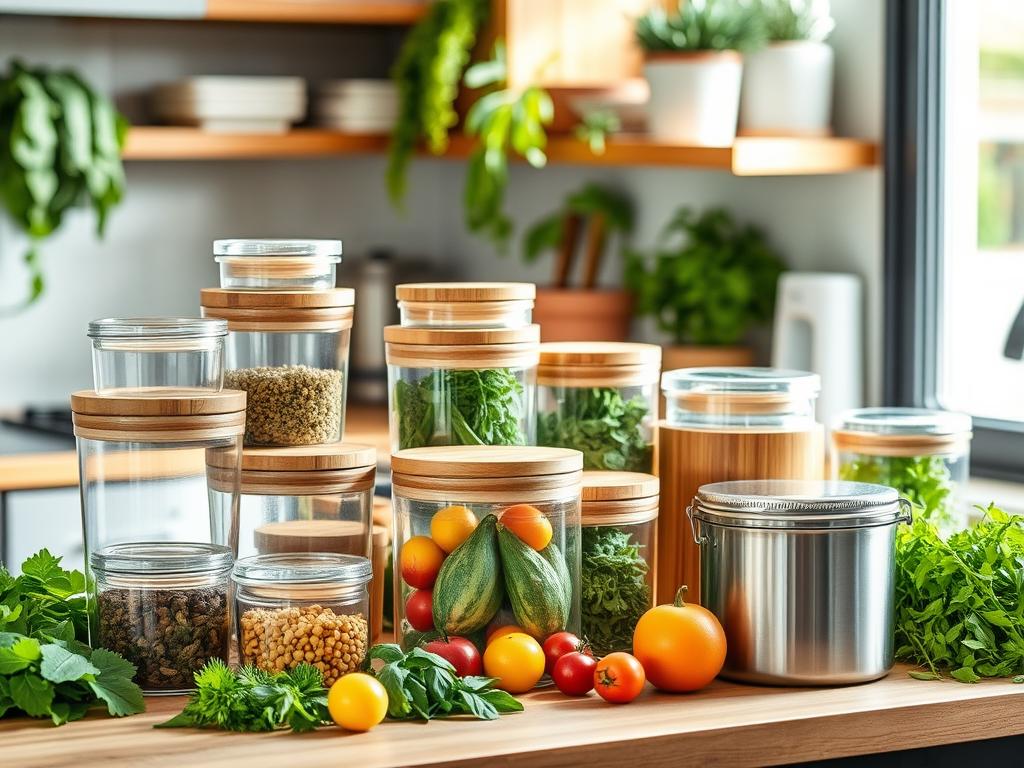
Essential Items for a Plastic-Free Kitchen
To make a plastic-free kitchen, you’ll need these items:
- Glass or stainless steel containers for food storage
- Wooden or metal cooking utensils
- Cloth napkins and reusable dish towels
- Beeswax wraps as an alternative to plastic wrap
- Stainless steel or glass water bottles
Companies like Penguinni are helping with this change. They’re launching a Silicone Steel Snack Container Set on August 5th. You can get 25% off if you sign up early.
Choosing these alternatives is a big step towards less plastic waste. It’s also a move towards cooking in a more sustainable way.
Historical Context of Plastic Usage
Plastic in our kitchens has a long story. It started in the late 1800s and has changed a lot since then. Now, we’re moving towards a plastic-free lifestyle.
Evolution of Plastic in Household Items
Plastic first appeared in 1862 with Parkesine. Then came celluloid in 1868. The big leap was in 1907 with Bakelite, the first synthetic plastic.
World War II made plastic production jump by 300% in the US. After the war, plastic took over our kitchens, replacing glass and wood.
The 1950s loved “throwaway living.” This meant using plastic items once and then throwing them away. Things like disposable cutlery and food containers became common.
The idea of a zero waste kitchen was not popular back then.
Changes in Consumer Attitudes Towards Plastic
The 1960s changed how we saw plastic. People started worrying about pollution and plastics. The 1970s brought the modern environmental movement and the EPA.
Now, more people want to live without plastic. They’re looking for safe, green alternatives. This change is also seen in laws banning single-use plastics worldwide.
Steps to Transition to a Plastic-Free Kitchen
Starting a green kitchen is easy. Begin by checking what you already have. Then, slowly replace plastic with eco-friendly options.
Assessing Current Kitchen Inventory
Look at what’s in your kitchen. Find out what plastic you use every day. Don’t get rid of everything right away.
Keep using your plastic items for now. This helps avoid extra waste. Your goal is to stop buying new plastic.
Choosing Sustainable Alternatives
When it’s time to replace something, choose something green. Glass containers are perfect for storing food. Beeswax wraps can last up to 12 months with care.
Stainless steel or bamboo utensils are better than plastic. They’re durable and good for the planet.
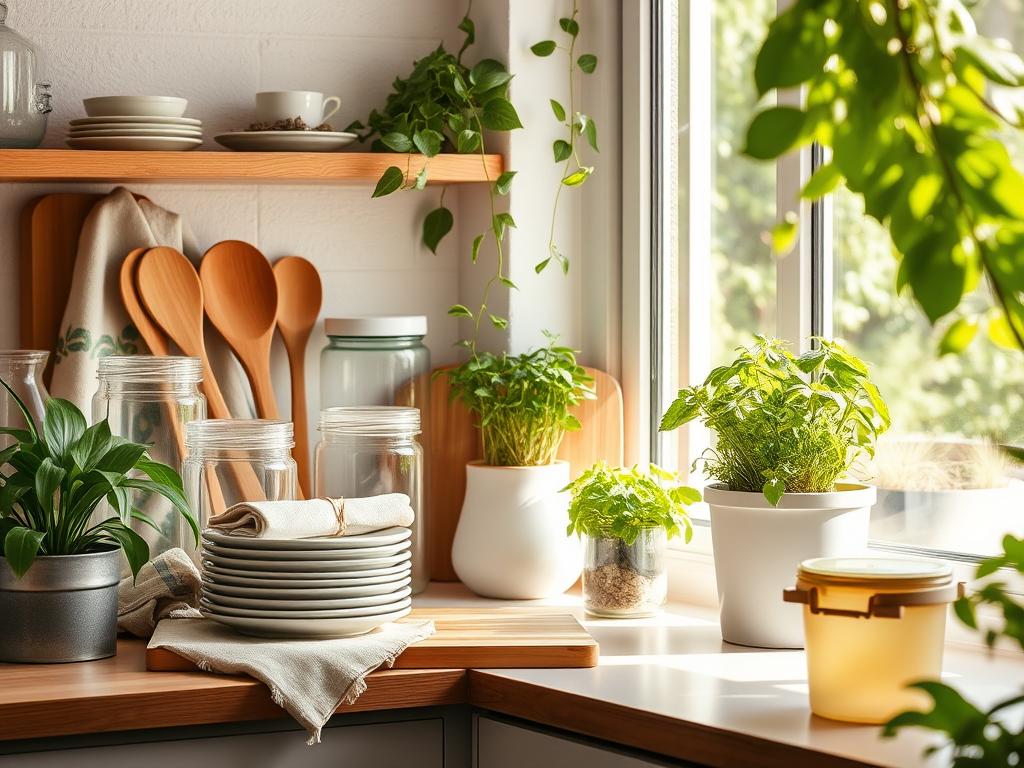
Implementing Changes Gradually
Change at your own speed. Start by swapping one item at a time. Focus on things you use a lot.
Look for refillable items like dish soap. Buying in bulk helps cut down on packaging. In 2014, less than 10% of plastics were recycled in the US.
Get your family involved. Share your dream of a green kitchen. Working together makes it easier. Keep finding new green products as they come out.
Your journey to a plastic-free kitchen is ongoing. But every step you take helps.
Tips for Shopping Plastic-Free
Shopping without plastic needs careful thought to cut down waste and choose green options. Smart steps can lower your plastic use and help the planet.
Finding Local and Sustainable Products
Begin by visiting local farmers’ markets. They sell fresh food without plastic. Use your own bags to carry your items. This small change can cut down a lot of plastic.
Search for stores that focus on green products and alternatives. Many let you bring your containers for items like grains and pasta. Using old jars can make your kitchen waste-free and save you money.
Reading Labels and Certifications
Always check product labels and certifications. Look for items with little or no plastic. Some important labels include:
- Cruelty-free (75% of businesses)
- Vegan (60% of businesses)
- Made with recycled materials (70% of businesses)
- Free of toxic chemicals (95% of businesses)
Choosing products with these labels helps support green businesses. Remember, 85% of eco-friendly companies use eco-friendly packaging for shipping. This effort helps reduce the 309 pounds of plastic waste each American throws away each year.
Maintaining a Plastic-Free Kitchen
To keep a zero waste kitchen, you need new ways to clean and store things. Using sustainable cooking methods helps cut down on plastic waste. This makes our environment healthier.
Cleaning Without Plastic
For a plastic-free kitchen, use eco-friendly cleaning products. Try plant-based dishwasher tablets and washing-up liquids. They are better for the planet than regular cleaners.
Swap plastic sponges for hemp ones. Hemp sponges are good against bacteria and break down fast. Making these changes can greatly reduce plastic waste in your kitchen.
Sustainable Storage Solutions
Glass jars are great for storing food in a zero waste kitchen. They keep food fresh and let you see what you have. This helps avoid throwing away too much food.
Studies say 40% of food in the U.S. is wasted each year. Good storage is key to not wasting food. Use glass jars for:
DIY Cleaning Solutions
Make your own cleaning products to reduce plastic waste. A simple recipe for a cleaner is:
- 1 part white vinegar
- 1 part water
- Lemon peel for scent
This homemade cleaner works well and is good for the planet. Making your own cleaners can cut plastic waste by half.
Keeping a plastic-free kitchen is a big job, but it’s worth it. With these tips, you’ll make your kitchen cleaner and greener. It’s a step towards sustainable living.
Benefits of a Plastic-Free Kitchen
Switching to a green kitchen has many benefits. It makes your home safer and more eco-friendly. By cutting down on plastic, you create a better living space.
Health Advantages of Reducing Plastic Exposure
A plastic-free kitchen keeps you away from harmful chemicals. BPA and phthalates can get into your food and drinks. This can harm your health. Using eco-friendly storage helps keep you and your family safe.
Positive Environmental Impact
Choosing a green kitchen cuts down on plastic waste. The average American throws away 309 pounds of plastic each year. Only 5% gets recycled. Switching to reusable items like beeswax wraps can make a big difference.
These eco-friendly choices reduce pollution in landfills and oceans. It helps protect marine life and keeps ecosystems healthy. By going green, you help the planet and encourage others to do the same.
- Reduced exposure to harmful chemicals
- Decreased plastic waste generation
- Protection of marine ecosystems
- Inspiration for sustainable living
A green kitchen is good for your health and the planet. It can also save you money. Cooking at home is cheaper than buying meals out.
Challenges in Going Plastic-Free
Switching to a plastic-free kitchen has its own set of challenges. Americans throw away a lot of plastic every day. Let’s look at some common problems and how to solve them.
Common Obstacles Faced
Finding alternatives to plastic can be hard. In a plastic-free week, someone still made 102 pieces of waste. Cost is also a big issue. Plastic-free toiletries, like shampoo bars, are often more expensive than bottled ones.
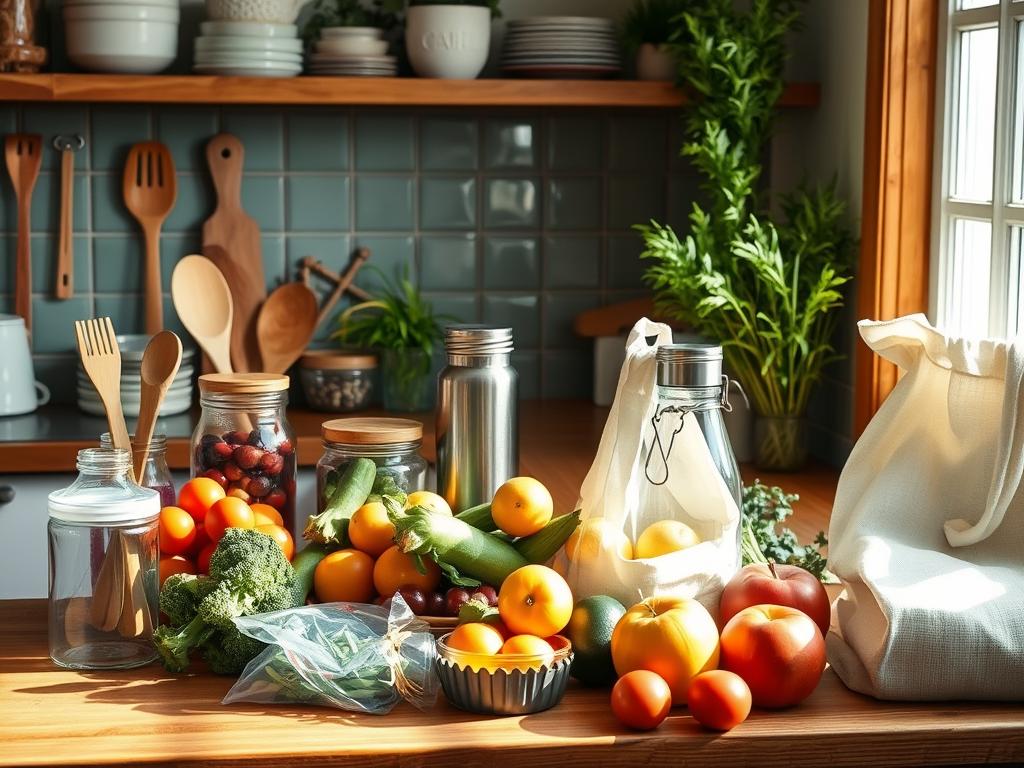
Strategies to Overcome Plastic-Related Challenges
Many people are finding ways to use less plastic:
- Use brown paper bags for bulk bin shopping
- Keep reusable bags handy for groceries
- Replace plastic wrap with beeswax-covered organic cotton cloths
- Use stainless steel straws for sustainable cooking practices
It’s okay if you can’t be perfect. A mom from Plainfield, Connecticut, knows it’s hard with a busy life. Start with small changes that fit your schedule. Gradually replace items as you can afford them. With effort, a plastic-free kitchen is within reach.
Resources and Tools for a Plastic-Free Lifestyle
Starting a plastic-free lifestyle can seem hard. But, many resources are here to help. In the US, people throw away a lot of plastic, and only a small part gets recycled. It’s important to find ways to live without plastic.
Recommended Books and Websites
“Say Goodbye to Plastic” by Sandra Ann Harris is a great book for learning about living without plastic. Websites like EcoRoots have lots of plastic-free kitchen items. These can help you make your kitchen waste-free, which is good for the planet and animals.
Supportive Communities and Networks
Being part of supportive groups can make your journey easier. They share tips on buying in bulk and meal prep. This can save you money and reduce plastic use.
Online, you can find places to recycle plastic and learn about new eco-friendly products. Remember, going plastic-free is a step-by-step journey. Start by turning off appliances and think about getting more energy-efficient ones. With these tips, you can cut down on plastic and help the planet.
FAQ
Q: Why is it important to create a plastic-free kitchen?
A: A plastic-free kitchen is key for health and the planet. Plastic can leak harmful chemicals into food, especially when heated. These chemicals can harm our cells and might cause cancer.
Also, using less plastic helps keep our oceans and landfills clean. This protects marine life and our ecosystems.
Q: What are some essential items for a plastic-free kitchen?
A: For a plastic-free kitchen, you need glass or stainless steel water filters, kettles, and containers. Beeswax wraps replace cling film, and reusable stainless steel coffee pods are great.
High-quality wood or stainless steel utensils are also essential. Don’t forget cloth produce bags and reusable shopping bags for grocery shopping.
Q: How can I transition to a plastic-free kitchen gradually?
A: Start by using your current plastic items to avoid waste. Then, stop buying new plastic items. Find refillable options for things you use a lot.
Replace old plastic items with plastic-free ones as they wear out. Keep looking for better alternatives as they come out.
Q: What are some alternatives to plastic water bottles?
A: Use reusable glass or stainless steel bottles instead of plastic ones. For home, install a water filter to clean tap water. This is better for the planet and saves money over time.
Choose glass or stainless steel kettles for boiling water. They don’t release harmful chemicals like BPA and phthalates.
Q: How can I shop plastic-free?
A: Start by avoiding single-use plastics. Carry reusable bags and water bottles. Look for plastic-free food alternatives and use cloth bags for produce and dry goods.
Buy in bulk and shop at local markets. Always check labels for plastic-free or sustainable packaging.
Q: What are some eco-friendly cleaning solutions for a plastic-free kitchen?
A: Use biodegradable, plant-based dishwasher tablets and washing-up liquids. Hemp sponges are a good choice instead of plastic ones. They’re antibacterial and biodegradable.
You can also make your own cleaners, like bio-enzyme cleaners. This reduces your need for packaged products.
Q: How does a plastic-free kitchen benefit health?
A: A plastic-free kitchen keeps you safe from harmful chemicals like BPA and phthalates. These can disrupt cell functions and might cause cancer.
Using glass, stainless steel, or wood reduces the risk of these toxins in your food and drinks, especially when they’re hot.
Q: What are some common challenges in going plastic-free and how can they be overcome?
A: Finding alternatives for packaged foods and the cost of some plastic-free items are common challenges. Buy in bulk and shop at local markets to save money.
Replace items as your budget allows. Remember, a plastic-free kitchen is about making practical changes that fit your lifestyle and budget.
Q: Are there any resources available for maintaining a plastic-free lifestyle?
A: Yes, many resources help you stay plastic-free. Books like “Say Goodbye to Plastic: A Survival Guide to Plastic-Free Living” by Sandra Ann Harris are full of tips. Websites like EcoRoots offer plastic-free kitchen products.
Joining communities and networks can help you share ideas and find local recycling facilities. Online resources keep you updated on new plastic-free options.
Q: How can I involve my family in the transition to a plastic-free kitchen?
A: Teach your family about the health and environmental benefits of less plastic. Make it a family project to find plastic-free alternatives.
Encourage everyone to share ideas and help choose new products. Involve neighbors and friends in your journey to plastic-free living.
Source Links
- https://consciouscharcha.com/plastic-free-kitchen/ – Create A Plastic-Free Kitchen In Simple Steps – Conscious Charcha
- https://www.seasandstraws.com/plastic-free-kitchen.html – Plastic Free Kitchen: 11 Ways To Make Your Kitchen Plastic-Free
- https://www.treehugger.com/beginners-guide-plastic-free-living-4858498 – A Beginner’s Guide to Plastic-Free Living
- https://www.marthastewart.com/best-plastic-free-kitchen-items-7484568 – 13 Plastic-Free Essentials for a More Eco-Friendly Kitchen
- https://toxicfreefuture.org/healthy-choices/be-picky-with-plastics/ – Be Picky With Plastics – Toxic-Free Future
- https://penguinni.com/blogs/learn/5-simple-swaps-to-start-your-plastic-free-kitchen?comment=133472288947&page=656 – 5 Simple Swaps to Start Your Plastic Free Kitchen
- https://www.seriouseats.com/how-to-reduce-single-use-plastic-in-your-kitchen-8767023 – How to Reduce Single-Use Plastic: Simple Steps for a Greener Kitchen
- https://www.sciencehistory.org/education/classroom-activities/role-playing-games/case-of-plastics/history-and-future-of-plastics/ – History and Future of Plastics
- https://www.4ocean.com/blogs/live-the-mission/plastic-pollution-history?srsltid=AfmBOooVUY24uBlVLTW6MmtKfC6Hdq3qxmSddDbtGUV3FUx2dILaZsyC – The History of Plastic Pollution | 4ocean | Plastic Pollution 101
- https://simplyspaced.com/2019/04/10-tips-for-a-plastic-free-kitchen/ – 10 Tips for a Plastic-Free Kitchen
- https://www.nationalgeographic.com/lifestyle/article/plastic-free-kitchen – How to reduce plastic in your kitchen
- https://umbelorganics.com/plastic-free-kitchen/ – 10 Steps To A Plastic-Free Kitchen – Umbel Organics
- https://earthhero.com/blogs/blog/zero-waste-kitchen-pantry?srsltid=AfmBOorFjdtiNeTHk9xfZW4w2XGDvXuQobAK6_n_Qo9qDQFEph3gICGS – Your Zero Waste Kitchen: 10 Easy Tips For A Plastic-Free Pantry
- https://www.implasticfree.com/post-category/plastic-free-kitchen/ – Plastic Free Kitchen Archives
- https://theplasticfreechef.com/avoiding-plastic/ – Tips For A Plastic-Free Kitchen
- https://earthhero.com/blogs/blog/zero-waste-kitchen-pantry?srsltid=AfmBOoq21-INMcNGlMj2AmqeIk24TFnJD8uDb_0G59ZH1f4y7825-zl5 – Your Zero Waste Kitchen: 10 Easy Tips For A Plastic-Free Pantry
- https://www.sustainablylazy.com/blog/plastic-free-kitchen – 18 Ways To Reduce Plastic In Your Kitchen on a Budget — Sustainably Lazy
- https://www.npr.org/2024/07/26/nx-s1-5021546/plastic-free-sustainable-living-tips – I avoided plastic for a week. Here is what I learned about a plastic-free life
- https://www.momscleanairforce.org/going-plastic-free/ – Plastic-Free Lifestyle Tips And Challenges From Busy Moms
- https://earthhero.com/blogs/blog/zero-waste-kitchen-pantry?srsltid=AfmBOoqoJRXtYPQbelzi8EclgU6P2pQzcLAQyYZZUAgloKZIpUrMm3Nq – Your Zero Waste Kitchen: 10 Easy Tips For A Plastic-Free Pantry
- https://foodrevolution.org/blog/zero-waste-kitchen-tips/ – Zero Waste Kitchen Tips for the Modern World
